
Pleonosporium vancouverianum
Alternate Skein
Interacted with at: Goose Spit, Kye Bay and Willow Point, Strait of Georgia, British Columbia, Canada
30 April 2021
Time collected: 09:45 am PDT
Tide at time of collection: 12.5 ft (measured at Comox Tidal Station)
Weather: Mostly cloudy, no precipitation, wind SE 28 km/hour, sea rough, temperature 10˚C, relative humidity 88%.
Phase of Moon: Waning Gibbous (approx. 85 hours into this phase at time of collection); (Previous Phase, Full Moon, 26 April 2021 at 8:31pm PDT: Next Phase, Third Quarter, 3 May 2021 at 12:50pm PDT.)
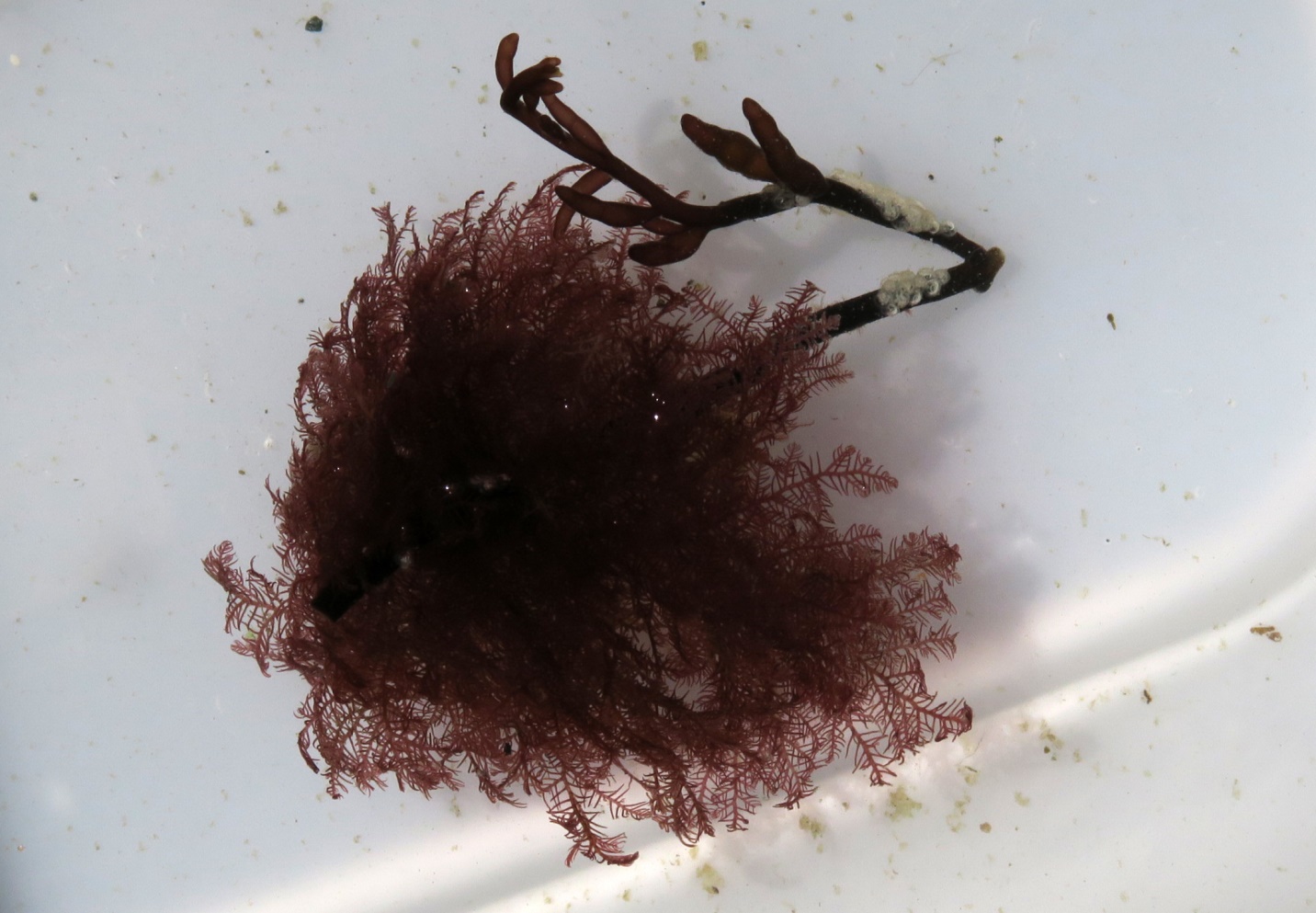
Figure 1: Pleonosporium vancouverianum, common name Alternate Skein – shown here in collection bucket. The thallus and some branches of its host alga – Neogastroclonium subarticulatum, are plainly visible as the much thicker and darker red stems. These seaweeds were found freshly washed ashore at Goose Spit, Comox, Strait of Georgia, B.C., Canada. April 30, 2021. Photo ID 27545 ©Seaweedwhisperings.com
In situ observations:
All observations were done on the shores of the Strait of Georgia. We interacted with the single washed ashore specimen (primarily in a tub of sea water) at Goose Spit, Kye Bay and Willow Point, BC. The location where it was washed ashore was on the exposed side of Goose Spit. Goose spit is a flexible sand spit fed by nearby Willemar Bluffs. This natural shoreline feature shelters the entrance to Comox Harbour. The ‘host’ species that our seaweed was growing in, Neogastroclonium subarticulatum or Sea Belly, is a red alga that often forms extensive mats at the low tide and subtidal region along rocky shorelines in areas that favored with ocean surge action.
Person 1:
Mop-top hairdo.
Along for “the ride” and enjoying it.
Like the plumose head of a feather duster tubeworm.
Very, very fine and tidy up close but looks like a mess from a distance.
Tiny attachment (clings not penetrates) on its “ride”.
I don’t think the host minds the Pleonosporium’s presence.
When the host breaks off (from the substrate) then Pleonosporium goes for a wilder “ride”, but enjoys it. It doesn’t need the solid attachment to ground.
Very soft to the touch like a fine cashmere wool.
Up close each thallus is symmetrical and curving, with neatly alternating short branches – attractive.
When pulled from water becomes an unattractive limp blob.
When out of its element it wants to be inconspicuous, perhaps wanting to totally disappear or vanish.
When not playing / riding it is inept.
Its main skill is to play and ride along.
Slightly gritty feel when chewed.
I didn’t notice any particular smell or taste.
Not a lot of depth or complexity to its character.
Simply riding along with smile on its face, not really interested in pursuing anything other than what it’s currently doing.
Absorbed in the moment.
I may have been attracted to this Whispering subject; it compelled me to engage, grabbed me, I felt a fascination and a magnetic draw.
The next morning, back at Goose Spit, more observations/impressions:
Kelp flies are streaming by, riding a gentle breeze; being swept up in the energy of the wind, by the ‘force’ of its presence.
You don’t fight it, Pleonosporium, either; you “go with” it – it’s instantly appealing. You are not choosing to go with, you simply do it.
Color purple-y red.
Much of its movement is defined by the action of the host (another); it does however have some independent movement. Not independent in any substantial way.
I got very little more at this second seaside session, as though the seaweed had nothing more to share with me. Maybe it couldn’t focus on more than one conversation at a time and decided to interact with Person 2 at this time instead of me (I noted Person 2 was busily writing notes).
Person 2:
I perceived clearly and immediately that this seaweed was fragile and knew to be very careful handling it.
Cool - must be kept cool. Cannot tolerate too much light or too much warmth. Examples of this came while handling the seaweed; took extra care to cover the seaweed and put it in the shade, and often collected extra cool seawater to refresh it.
When I first found this seaweed on the beach I thought, wow, that’s one TINY seaweed!
I noted it was growing epiphytically on another alga, Sea Belly, Neogastrocloinum subarticulatum. So what had washed ashore just a few moments ago is a delicate, ever so delicate, red seaweed growing on another low tidal/subtidal red seaweed.
My newest seaweed guide helped us identify and confirm this to be one of the “Skein” seaweeds.
How could it be so simple?
Sometimes, maybe it is.
Tiny in all ways – diminutive. The longest stems are no more than 2cm.
The main thalli are smaller in width than my finest sewing needle or thread. Then the tiny and short side branchlets are even thinner.
Seen individually (which one must manipulate the alga deliberately to do, or is seen only at the very edges) the branches and branchlets are a pretty rose pink, but when seen ‘en masse’ like a powder puff or feather duster, the color collectively looks to be a lovely deeper burgundy.
The branches are alternate and they grow sub-branches too.
There is an organization / growth pattern to this alga – one that is not apparent without close investigation. When its host was anchored to the substrate the Pleonosporium’s main stems grew out from a central point (radiating) and then gracefully curved gently downwards near the tips, maybe reminiscent of the arc of palm fronds.
Gravity or water pressure pulls on the tips and the branches have no strength to resist and so bend with the force.
It grows as a cluster. I don’t know if it’s all “one” plant, or many plants all growing in one location on the Sea Belly thallus.
The Sea Belly (host seaweed) looks so large and clumsy in comparison – the thickness of its stem is 1.5mm and it literally looks HUGE in comparison to Pleonosporium!
When I touch the Pleonosporium fronds as they naturally extend underwater, my finger is not sensitive enough to detect if I’m only moving my finger through water or if I’m actually brushing the seaweed. The seaweed has that little strength to its structure that it puts up no resistance to my touch. It only goes with and bends to a greater force.
With a hand lens I looked at the specimen – it seems that the Pleonosporium is clinging to the Sea Belly thallus with tiny attachment threads/roots, like English ivy does growing up a vertical wall or tree trunk. It holds on very well.
With the naked eye it is impossible to tell how this seaweed is attached (to its host) – you could even wonder if it’s just ‘perched’ there – a puffy red cloud in the midst of the other alga; but its appearance (when examined up close) is bit too lovely and orderly to be happenstance, to be possibly just caught temporarily in the ‘arms’ of Sea Belly.
Pleonosporium does remind me of the feather duster tubeworm I saw a bit earlier this afternoon. Pretty fronds, delicate, feathery and radiating out from a central point.
You are so delicate looking. How do you thrive down sub tidally in the shade where the least light reaches?
Maybe being so diminutive and so delicate and willingly bending to the larger forces around is your power…?
Maybe few herbivores harm you because you only catch the focused attention of the most observant other beings…?
You are safe and secure – as long as your anchor seaweed / host does well.
And how does Sea Belly feel about hosting you?
I think Sea Belly is quite annoyed and irritated by your clinging parts and would prefer to brush you away, BUT your grip is unshakeable – many, many, many tiny clinging ‘roots’ ensure you stay where you choose to be.
Broke a small piece of Pleonosporium off to taste it.
My teeth are too huge to really easily macerate the small ‘bite’ of seaweed I chose. It felt like a small clump of fine hairs or a wee small herb that really would be best just swallowed whole.
There was no point in chewing it as it resulted in no smell or taste – no added ‘dining’ pleasure.
I wonder if one would have to eat the whole cluster of branches for this alga to make any notable impression?
Again, I note the idea in this seaweed that they can easily escape close attention, make little impression.
What does that give the freedom to be or do?
And, conversely, how does that harm or limit their life and development?
Five minutes after swallowing (the piece of seaweed) I have the unpleasant feeling in the back of my throat as if the seaweeds little ‘rootlets’ have managed to grab hold and anchor to the side of my esophagus. I want to drink some water to see if I can wash this down! I definitely DO NOT like the thought of this taking up residence in the back of my throat.
The tiny, tiny branches are so numerous – this must give lots of surface area to photosynthesize with what rays of light reach you.
It also must mean you have very little drag or sail – but that maybe doesn’t matter so much for a life lived mainly sub-tidally.
I’m aware, yet a while later, that the back of my throat still feels “wrong” like the rootlets and branchlets of this seaweed are fastened there – like a squatter taking up residence where I don’t want it!
My finger wasn’t sensitive enough to detect this alga in water by touch alone – I only knew I was touching it by seeing that I was doing so. However, it seems to me that if YOU wanted to touch and hold onto ME, Pleonosporium, I would feel that – that there would be an irritation that I would have no power to ignore or scratch away.
If you decided to hold onto me, I’d be stuck with you for good and I’d be ceaselessly reminded of your presence; reminded not in a loud or powerful or dominant way, but in an unabatingly, relentless and forever-marring-my-shadow kind of way.
Pleonosporium went for a ride – or is it that we TOOK IT for a ride? In actual fact that’s exactly what we did, we transported it from Goose Spit to Kye Bay and finally to Willow Point where we gave it our full attention.
Why did we do that?
We were undecided.
We were looking to see if we would do a Whispering, and if the answer was to be yes, then what species would we be inspired to interact with.
Subtidal home equals more stable conditions.
Doesn’t reach far, truly diminutive, but reaches / branches in all directions - is that about balance, symmetry, or simply the best way to give space to its branches? No, it feels like it is just a haphazard expression…, a growth pattern that works, but that is unplanned, disorganized and indiscriminate.
Yes, in objective measurements this seaweed is diminutive, but in comparison, if a Bull kelp was 0.20mm in diameter how long would it grow; maybe not much more than 2cm?
So, actually your size is proportional – two centimetres long, when your stem is this skinny, is actually quite a distance.
Doesn’t feel a need to know everything – can rely somewhat on the knowledge of others.
Pleonosporium knows that the knowledge exists and can ‘piggy back’ on that.
The next morning, back at Goose Spit, more observations/impressions:
So tiny, even if I see you I can’t quite really see you with accuracy or full detail.
So puffed out, like a feather duster, a cloud of red alga, the outer fronds hide what is in your inner aspects.
Collapsed if you happen to be exposed and out of water – you look like a dark and uninteresting blob.
So many ways to be uninteresting and not draw attention to yourself, yet in the right place, where conditions suit you just fine, you fan up and out in graceful, delicate, red, arcing fronds.
You must attach to others in order to grow.
Is that ‘other’ chosen by happenstance?
What you live on, a rock, a sea creature, another alga, will determine much about how your life experiences go and maybe even how well you thrive and how long you live.
Your “success” is linked to or dependent upon where you grow, but it feels like your selection process for this ‘place to grow’ is not a weighty matter.
You see something workable and you go for it! Not too much forethought, and really no concerns or fears either.
Going for it really overrides any kind of hesitation.
The pom-pom, feather duster, cloud of red or powder puff – all of these things are assigned traits such as “airhead” or just “fluff” as if intelligence is not very much present.
I think you do not lack intelligence at all, Pleonosporium, but you certainly don’t lead with that, you don’t project it or interact with intelligence first and foremost.
What you do harness for your actions is spontaneity – you go where your desires lead you.
If that takes you into tricky places or dangerous waters, well, you’ll deal with that then.
But right now, wow, you’re truly engrossed and “all in” what you’re up to and what you have in front of you in the moment.
Our specimen, it got washed ashore as it clung to a broken stem of Sea Belly. It didn’t choose to travel quite so far, and indeed this trip will be its last.
However, I think the ride on the wave that took you from your watery home was experienced / sensed fully – a thrill to fully embrace, until you landed on Goose Spit – marooned and headed towards your death.
Alternating branches – this direction, then move a bit along, then the other direction, move a big along, then back to the first direction, and so on.
Does this give you balance and strength? Or do you proceed in fits and starts?
Checking in with the energy of the seaweed I sense that, yes, it’s that this energy proceeds / moves / acts / flows in fits and starts; it is inconsistent, varying, changing and erratic.
At your edges I can see hints of the delicate and tiny branches that you are comprised of – a glimpse of your potential, even genius. When I look at your core, I just see a mess of burgundy – a muddle of ill-defined character. This obfuscates, limiting the outsider’s ability to see who you truly are.
Do you see, for yourself, who you truly are?
What do you use your intelligence and life drive for? As yet it is undefined. You are undecided.
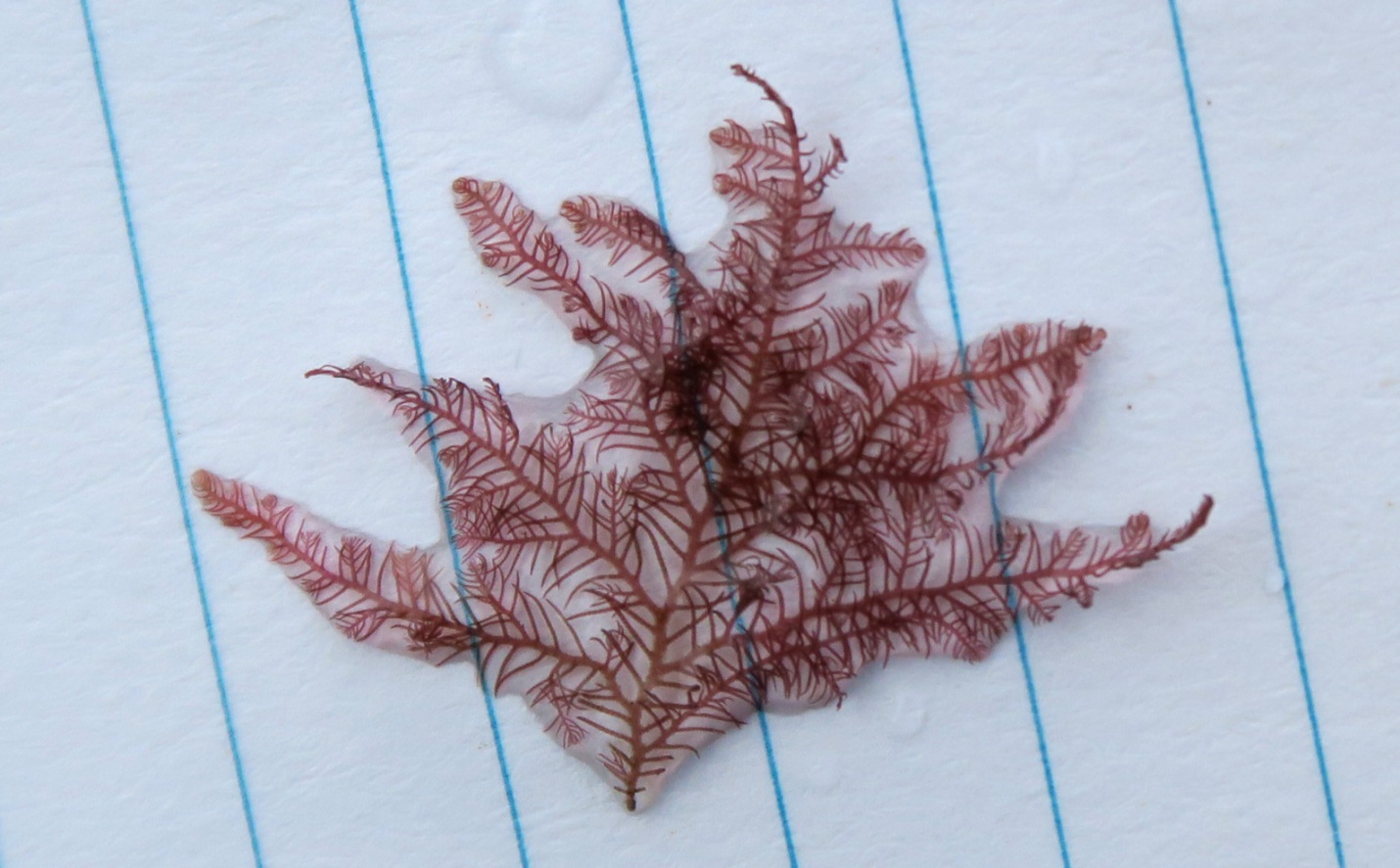
Figure 2: Pleonosporium vancouverianum – this image shows one thallus floated onto a sheet of waterproof paper revealing clearly its “alternate branching to several orders” pattern of growth. This distinguishes it from other “Skein” seaweeds in our area. For scale, note that the actual size measurement of the spacing between the blue lines of the notebook paper is 6.5mm. Goose Spit, Strait of Georgia, B.C., Canada. April, 30, 2021. Photo ID 27546 ©Seaweedwhisperings.com
Observations continue:
“Alternating” reports / “pictures”, from Person 1 and Person 2 as the Whispering continued to unfold, (Day 2, evening at home):
Person 1:
A small misunderstanding today led to an upset this evening. I felt the most depressed that I have in years. I was feeling totally fragile, worthless and inept. “Inept” is the word that came to me, without my recalling I’d used it in my first interactions with the seaweed.
However, there was something that didn’t feel ‘right’ about this, it seemed out of proportion, and I couldn’t…, I couldn’t connect with it, couldn’t make any sense of it [no access to rational thought] in spite of trying to. Something said to me that I shouldn’t be this depressed [as relates to the original upset], but I was definitely feeling deeply depressed.
I got up, went to my computer, sat there for a moment and I thought, “I feel like I want to quit just about everything”. The theme once again of INEPT; one definition is: inappropriate often to an absurd degree. I thought I’d totally quit bird watching [my main lifelong hobby / interest and one that I am actually quite skilled at indeed – the opposite of inept. I was going to destroy all my bird records, unsubscribe to all bird groups, delete all my photos ever taken – the urge was to obliterate all of my past contributions and accomplishments. All those felt utterly worthless now. Prior to this Whispering state, these records were a symbol of what had been important to me and now that I was totally absorbed in my feelings of inadequacy and ineptness… they had no meaning at all.
Included in this destructive impulse was a desire to punish – to take away from others / the world at large anything that they may have thought useful; a childish desire to “take all my toys and go home”. The feeling was “they don’t value me for who I am and they don’t appreciate what I consider to be valuable”.
Person 2:
Talking with Person 1 wasn’t working – communication was somehow just NOT happening, just like it had been not working earlier in the day. Frustration was felt but also I thought about it not working again. My response earlier in the day had been to keep trying to rephrase things, to say it another way, to express it better…, but that didn’t help. Now that the same problem was back, I thought, maybe I’ll just stop communicating. Talking it through didn’t seem to work, so maybe not talking at all will be a better option. And so I did, I just dropped trying to communicate by speaking with Person 1.
Day 3, Person 2:
Reviewing photos, early morning of 2 May 2021:
While diminutive in size this Pleonosporium vancouverianum seaweed, seen as attached to the thallus of its Sea Belly “host”, actually dominates! The space it occupies overall in the water is much bigger than that of the Sea Belly seaweed. Pleonosporium takes up a fair bit of space but it is not dense – it is airy like a cloud or powder puff…, whereas the Sea Belly is dense, substantial; it’s mass concentrated. In spite of that it tends to be dominated and / or get lost in the blur of multiple red feathery Pleonosporium branches that envelop it.
The size can be big, in area occupied by Pleonosporium, but not in mass.
The size of its energy can be BIG, too, especially given that it can be easily overlooked as insubstantial.
Transcribing session, Morning, 2 May 2021:
We were doing a transcribing session. Person 1 was reading notes aloud and Person 2 was typing them in to the digital document. Our original notes are made with paper and pencil, not with electronic devices so this step is a routine part of our record keeping process.
At one point, Person 1 was overwhelmed with emotion; he read part of a sentence and couldn’t go on. The sentence was from Person 2’s notes at Goose Spit:
“However, I think….”
Person 1 described what the emotional response he was experiencing related to, saying, “This last page sounds just like me; I have no idea why it makes me so emotional. I was actually getting some of this last night, these fairly short bursts of sadness, maybe depression, but they were short.”
The full sentence he was reacting to is:
“However, I think the ride on the wave that took you from your watery home was experienced / sensed fully.”
When queried as to what he was feeling that caused the upwelling of emotion, Person 1 said: “It seems to me that something gets in the way for me to ‘enjoy fully the ride’ on many things. Maybe I have a longing for that”.
It seems that Person 2’s original observations and Person 1’s intense emotional resonance with them has brought into prominence one of the gifts of this seaweed’s energy – the capacity to enjoy fully the ride.
It is probable that this could also relate to why some people are attracted to the Pleonosporium energy, feeling an effect not unlike magnetism. There’s something they admire and want to be a part of and it is most likely this trait, this fully sensed and experienced “ride” that Pleonosporium can access so naturally.
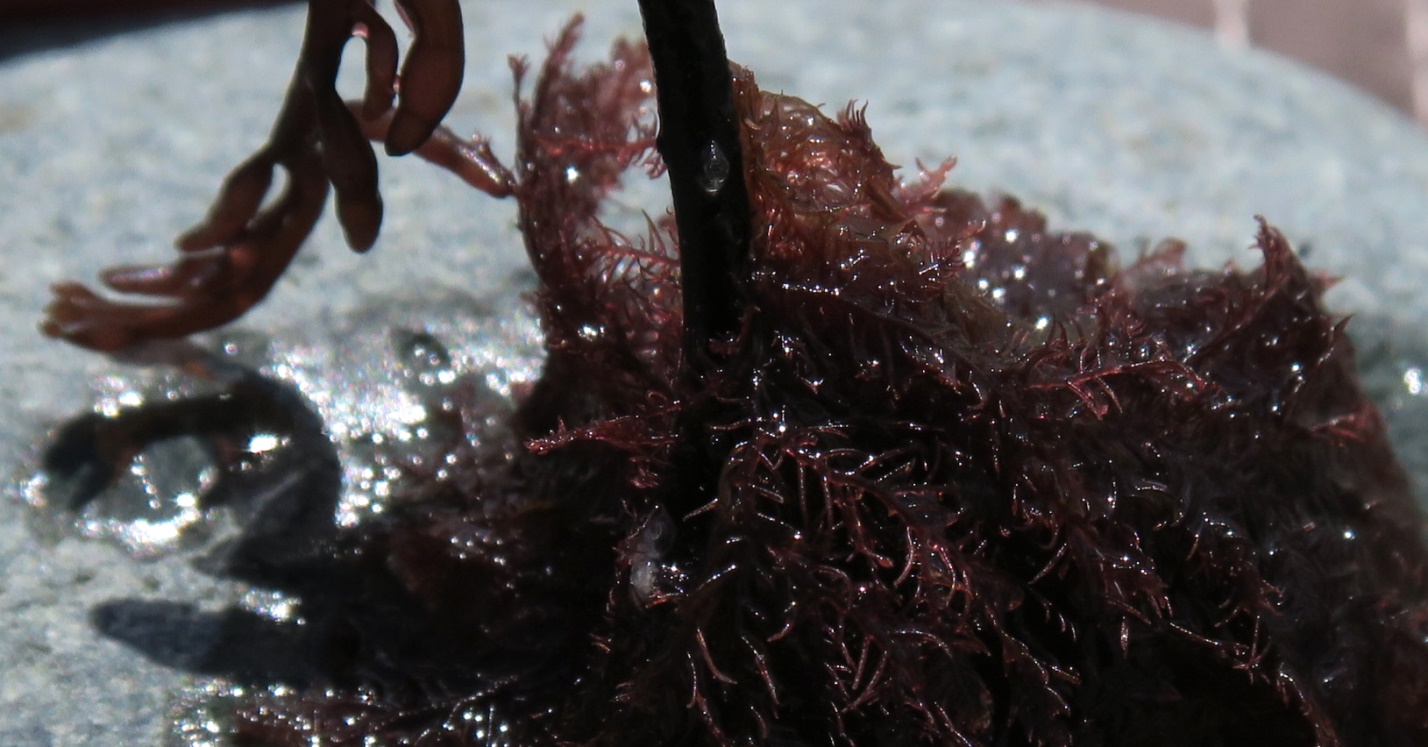
Figure 3: Pleonosporium vancouverianum – closer view. Goose Spit, Strait of Georgia, B.C., Canada. May 2, 2021. Photo ID 27547 ©Seaweedwhisperings.com
Listening Further:
The attachment place it chooses does not need to be solidly grounded; it can pick a ‘host’ that is grounded solidly at its base, but the Pleonosporium site of attachment can be separate from this grounded place and thereby be wafting around higher in the water. So, it actually isn’t grounded in reality itself. Its host is grounded; Pleonosporium is riding the host – so a different thing entirely.
You could be really attracted to it or repulsed by it. That would be likely an individual reaction as well as a situation to situation reaction; either you felt attraction or repulsion.
Alternating, there may not be anything in between attraction and revulsion. Little “middle ground”.
I love it, or I hate it. Raw and strong response / feeling to this energy.
“When out of its element” – this is a state of notable distress to Pleonosporium.
Inept – this word came through strongly as one description of the Whispering energy.
Inept – definitions: Generally incompetent. Lacking in fitness or aptitude. Not suitable to the time, place or occasion. Inappropriate often to an absurd degree. Lacking in sense or reason, foolish.
Absorbed in the moment.
Absorbed in and / or absorbed = engrossed, captivated, occupied, engaged, gripped, immersed, enthralled, involved.
Not choosing…, simply do! Indiscriminate, or not able to be discriminating yet.
Fully absorbed with the one conversation / not really capable of running more than one conversation / activity / thought at a time.
Conditions need to be just right, the way they want them to be – narrow tolerance.
Notably different with this Whispering is:
We found it (for the first time ever), identified it, and commenced our interactions with it – all in one day.
Impulse. Went with it.
Too easy?
Or, maybe, it’s a case of recognizing a “rare opportunity” and going with it!
And it is a rare opportunity…, because Pleonosporium only interacts when IT wants to!
It has to say, “I’m ready”, or else you’re going to get nothing.
On some scales of measurement, this seaweed is so tiny, it wouldn’t even register. We saw this relating to the energy in the following ways:
The seaweed is impulsive, following their urges, childlike, and they therefore could potentially be totally ignored – that’s one way to be / feel “small”.
They can be not fully ignored but simply disregarded by others who feel they don’t measure up, are not worthy of attention, are simply just an annoyance, & have nothing of value to offer.
They can have a weakly formed identity or ego – another way to “be” small.
In a “forever-marring-my-shadow kind of way”…
I wanted very much to phrase this in a way that brought in the concept of ‘shadow’. That is interesting in that “to cast a shadow” means to cast doubt on something. I wonder if the energy of this seaweed imposes some doubt on others…, it doesn’t feel like Pleonosporium itself suffers from struggling with much doubt itself.
The seaweed goes for a ride or is it that others / other forces take it for a ride?
It doesn’t have the feel of a parasite but it’s also not self-sufficient.
It needs things from others, maybe attention, but only when and how it suits it.
It doesn’t have a lot of depth to it, not much ability yet, only narrow range of survival conditions and narrow range of abilities.
It feels like Pleonosporium has a haphazard expression…, a growth pattern that works, but that is also somewhat unplanned, disorganized and indiscriminate.
Is it as yet incapable of exercising much discrimination about actions and choices?
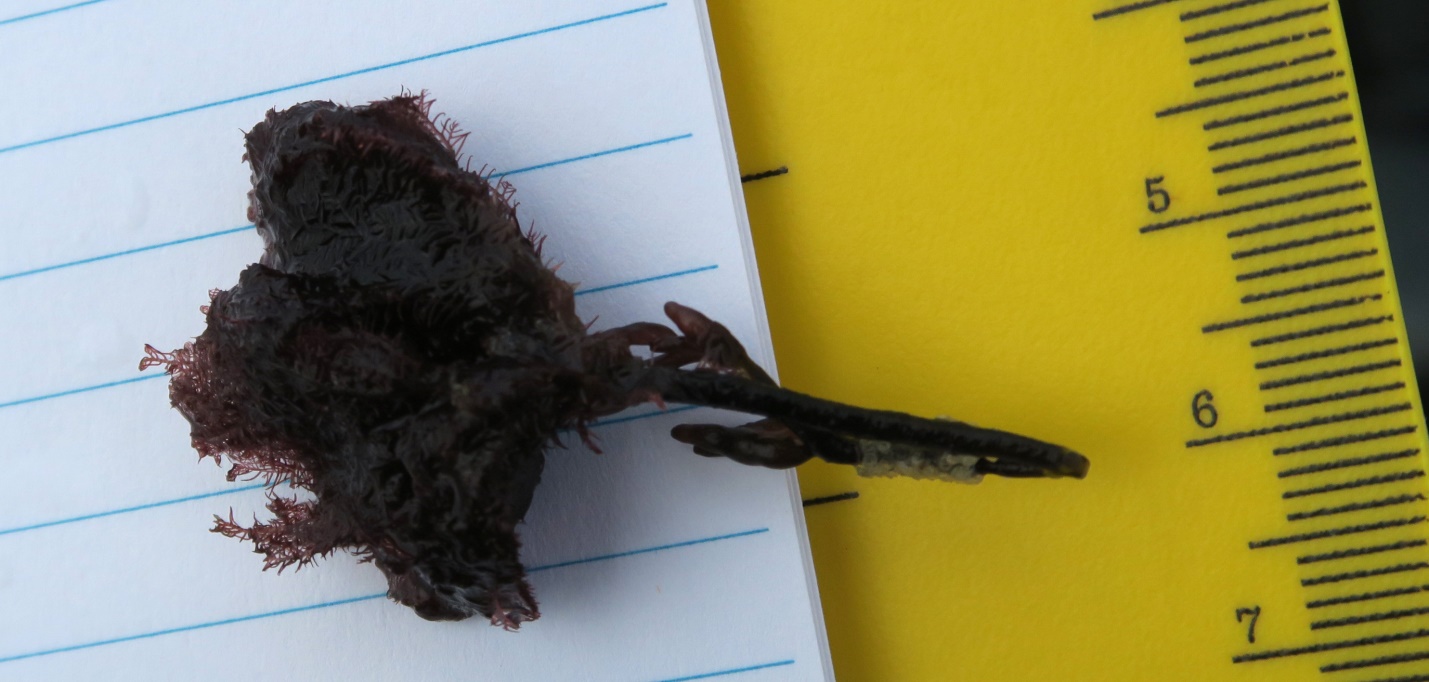
Figure 4: Pleonosporium vancouverianum, our alga pulled out of water and laid out exposed to air. Its fluffy pom-pom shape instantly collapses to this amorphous reddish blob. Only at the very fringes can you see any individualizing features. Willow Point, Strait of Georgia, B.C., Canada. April 30, 2021. Photo ID 27548 ©Seaweedwhisperings.com
Person 1 and 2:
For all other Whisperings we’ve conducted thus far we have deliberately considered the connotations related to the names, both common and scientific, of the particular species. For this one, however, we both did not want to evaluate this at all.
We definitely did not want to even use the name “Alternate Skein”. When writing up our record any time we considered using a name, we went with Pleonosporium and decidedly rejected ‘Alternate Skein’ and even went through any early notes and to replace ‘Alternate Skein’ with ‘Pleonosporium’. Such was the strength of our dislike for that name; it felt unpleasant, even repulsive.
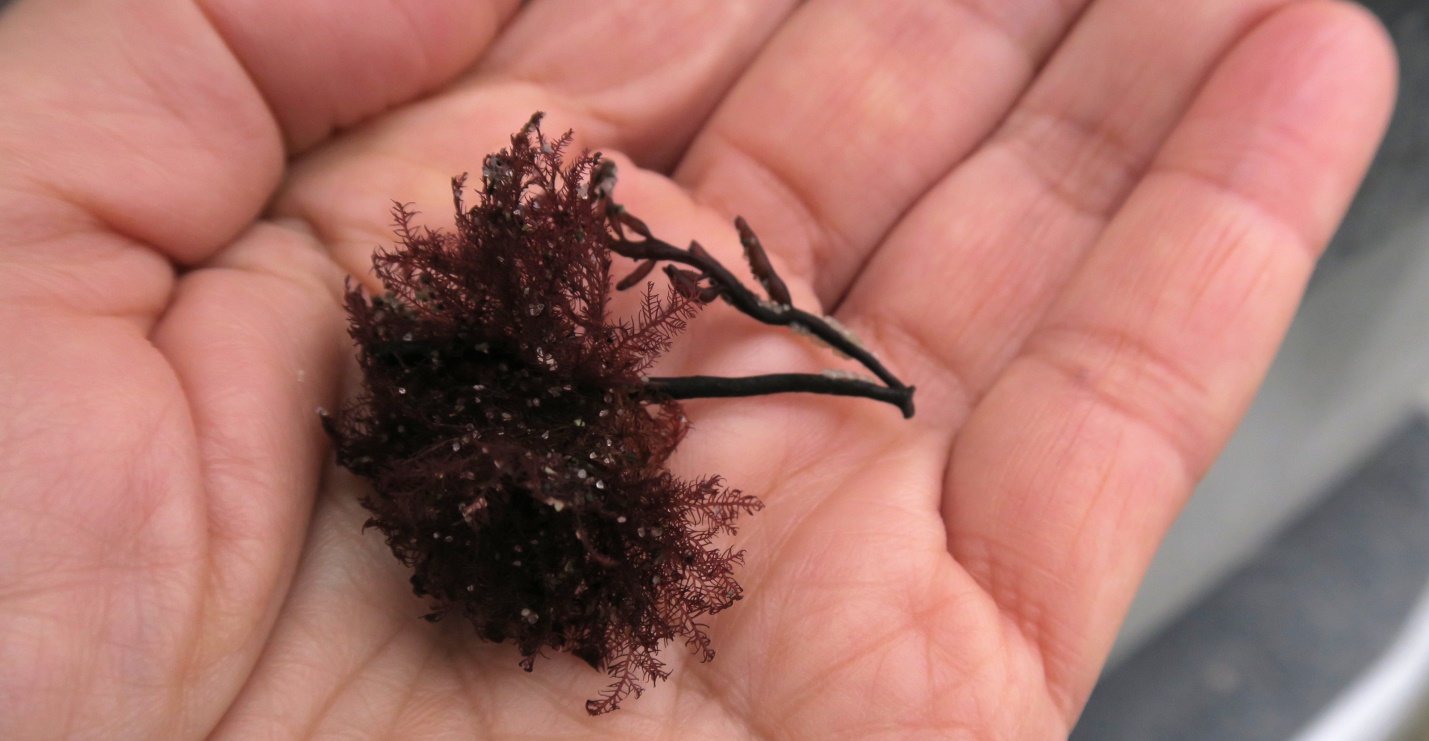
Figure 5: Pleonosporium vancouverianum – cupped in Person 2’s hand shortly after it was discovered washed ashore on the sand and cobble beach at Goose Spit. This photo reveals the diminutive size of this alga; the ‘salted-looking’ white specks are grains of individual sand still clinging to the seaweed. The width of the main thalli measure less than these grains of sand. April 30, 2021. Photo ID 27549 ©Seaweedwhisperings.com
Discussion:
Especially after we returned the Pleonosporium vancouverianum specimen to the sea (at Goose Spit where it had originally washed ashore) it was as if this Whispering pulled us in for “a ride”. Earlier in the interactions we had been in the position of ‘observing’ “the ride” aspect. After it was returned to the sea and we allowed space for our observations to gestate / percolate / continue, it was only then that we got swept away and into the full energy of this seaweed.
What power does this little seaweed have to do that…? To pull us in like that…?
When Pleonosporium is going for it there is no hesitation, it is “all in” – this way of being creates a draw, almost a force field, and others can easily be pulled in. Once pulled in for “the ride” emotional energy dominates and rational thought is suspended or certainly secondary.
Others can give up on the Pleonosporium individual – there seems to be no point in talking to them and they can seem to ignore everything you say.
Like the absence of smell and taste giving nothing to any dining /eating pleasure, interacting with Pleonosporium usually has little reward, unless they choose to be interacting with you.
Pleonosporium doesn’t usually appear to respond to input; it seems actually that they don’t even take in input much of the time therefore a response to said input would not even be possible. Because of this trait, if others have been trying to interact with the Pleonosporium individual they may give up entirely or keep trying and trying, eventually reaching the point of their own total frustration. This then brings up their own emotional vulnerabilities and Pleonosporium is oblivious to all of this.
It seems that the only input that is received (well) by Pleonosporium is something that is in direct and immediate response to what they themselves initiated or acted upon. The rest of the time they seem numb, unresponsive, unavailable, etc.
Often what they can chance upon with their “all in”-and-going-for-it impulse is something unseen by others; what they “see” could be unappreciated, misunderstood, disregarded or missed entirely. Their “discovery” is something possible because they do not yet hold or even know the limitations of much personal experience or societal norms. They simply go for it – nowhere in them is an evaluation of whether they can or can’t do it.
Has a presence, a definite and often ‘large’ presence. Frilly fine red fronds give a ‘show’ but there is little substance / density to their character. Pleonosporium has a personality, yes, but they’re only coming to understand it for themselves, and they do not understand how their personality impacts others.
They are often unresponsive to interaction. Outsiders trying to reach in or connect with them will be brushed off or ignored; others find this quite puzzling or off-putting.
When they are in their full sensory experience ‘mode’ – utterly absorbed, they can be distinctly unresponsive to outsiders. Thus the outsider might conclude that they’re numb, unresponsive or blocked off; this is the opposite of what is going on internally for Pleonosporium.
It’s like looking at the blob of red filaments that make up this seaweed – you can see it, but you can’t know it. This aspect made it quite challenging to feel that we were truly accessing and accurately reporting the seaweed’s energy. In fact, trying to communicate about and report accurately and attempting to “make sense” of this Whispering for others was extremely tiring – at times it actually felt like our brains hurt from the strain of it. It was as if trying to put this experience into rational terms / thoughts / sentences required a supreme effort.
Bits and pieces…, left half done…, all over the place… this is the energy of this seaweed.
The field notebooks illustrated this; multiple separate and additional notes, 3 or 4 or 20 of them, made on whatever paper was handy, came to be scattered throughout our vehicle and house.
Our offices and home were in a similar state – strewn with multiple incomplete projects. Laundry half done here, plants half watered there, case write up incomplete, exams marked but not submitted, groceries purchased but not put away – to give only a very few examples.
The Whispering unfolded in fits and starts – often feeling as if it was in a haphazard fashion.
It is fair to say that for us that with this seaweed trying to proceed in a consistent orderly fashion was simply and utterly incompatible.
Whenever we go to the seashore with the intention of possibly doing a Whispering, we do our best to be ‘open’ to feel which, if any, seaweed is available and willing to interact. Notable with this interaction is that we took it up almost “on a whim”. Clear intention about the process was not absent, but if we’d not followed the impulse after just having found and identified Pleonosporium vancouverianum we have the sense that we may not have chosen it in a more considered fashion. It strikes us that this may be characteristic of how most Pleonosporium actions / interactions happen.
Poor ability to judge magnitude, something small can mushroom into something very big. The theme of “size” is significant – diminutive and tiny, or actually very big and huge…?
Pleonosporium has few, if any, blocks in its sensory input – this is how it experiences the world, fully, senses wide open. Pleonosporium feels, physically and emotionally, utterly and totally; what Pleonosporium is not so open for is interaction with another. They are so fully absorbed, engrossed, immersed in their own experience that they do not want to be interrupted by interactions beyond the one they are currently engaged in. They cannot take in anything more, after all they are fully engaged, and they do not want to switch their focus unless that urge comes from within themselves.
So, much of what Pleonosporium knows, it knows only to itself – it is a solitary experience that is not shared and it feels like this is because they don’t yet really have good skills or the basic capacity to be able to share it. Pleonosporium individuals may have tried to do so, and they can feel “put down” or “shot down” before ever being able to really say many words in the attempt to express their thoughts or perceptions. They often can be wary of this and feel not up to defending themselves or picking themselves up once again after being battered. They can develop a very finely tuned “off” switch. They close down to interaction with others as they can so often feel diminished by such interactions.
Pleonosporium is really good at being in and playing in the realm of I-don’t-know-and-I’ll-just-be-here-fully-experiencing; they’ll learn what happens by doing that but they don’t have an agenda to learn by doing that. Most others they know will not be OK to be in that realm; they may become impatient, they’ll soon be looking for something else, or to take it further, or to have a result from it. Few can meet Pleonosporium as equals in the amorphous ‘playground’ that is their preferred way to be.
Another way of looking at this trait is that Pleonosporium is very much experiencing in a primal and instinctive way – it is not yet putting much effort into amassing knowledge via the realm of the intellect. So this type of energy regularly can meet disapproval and negative judgement for their style or type of knowing. Also, Pleonosporium can also find factual knowledge to be quite boring and they are disinterested. In this process, living experientially and making choices haphazardly, Pleonosporium doesn’t anticipate outcomes. They can find themselves, as the result of an unfortunate urge, having learned what works and doesn’t work, and also, by the measure of others, what is bad or good.
There can be a rather childish punishing-the-other theme. Often this can be an impulsively destructive act. It is to say, “There, I’ll show you!” but it often cuts two ways. It’s like the expression, “don’t cut off your nose to spite your face”. Sometimes the hastily carried out fits of destruction that can mean one is often set back to “starting all over again”. An outburst, with little learning or integrated experience, puts you right back at square one.
Communication is not natural and easy with this seaweed. There isn’t true skill in this area yet. It doesn’t go well and leads to upsets or feeling diminished and misunderstood. As such, communication is often simply just not attempted, shut down totally. It could be like a person suddenly finding themselves in a foreign land where no one speaks or understands their language – communication is all but useless to you, so you abandon further attempts.
Pleonosporium energy is totally absorbed and immersed in doing it their way, when they want, how they want, if they want…..and, if allowed to proceed like this uninterrupted, this could be a path to new discoveries and great accomplishments – a kind of genius. However, much of the time, to the outsider this self-absorbed / immersed Pleonosporium individual appears to be unresponsive, uncaring, stubbornly selfish, inflexible, irrational and unproductive.
There is this alternating aspect to the seaweed; they are either really ‘in their energy’ and contentedly self-absorbed about what they’re up to in the moment, or they’ve suffered a sudden blow to their ‘young / newly developing’ sense of self, and then they are totally absorbed in passionate and often out of proportion emotional reaction to that blow.
One can try to connect with the Pleonosporium individual, however true connection is really only possible when the Pleonosporium individual reaches out to connect with you. Connection and interaction is unidirectional with this seaweed.
Added to this is the fact that they don’t ‘decide’ to do or act, they just do it. So it can seem that is really only “by accident” that a connection or interaction is made with another. Also, the “just doing it” aspect means they may land on a positive action or, just as possibly, a distinctly not positive one. When they land on a negative one, they can feel utterly crushed, enormously disappointed and even disillusioned.
At one point while we were doing our reporting of this Whispering experience we decided to add to the routine title/header such that it would read as:
Observations & Interactions – Listening Further – and the Meaning of the Universe.
One could think this was just a note made simply ‘in jest’ but there is indeed a notable aspect to this seaweed’s energy that is actually closely connected to (or freshly remembering) ‘the universe’, the ‘all knowing’, the omnificent ‘divine’. As our attempts to report and describe this ‘energy’ proceeded, we found it to be exceedingly challenging. This is the Pleonosporium challenge – a state of ‘knowing’ along with the inability to share and express that knowing.
The one way that they can ‘share’ their knowing is through what is often a quite specific genius. This genius, as presented by the Pleonosporium individual, is sometimes appreciated for what it is; other times it is misunderstood, met with disbelief, judged as too absurd or “out there” and does not pass critical review.
They can connect, it seems, with that which is omnificent (unlimited in creative power) and in their earthly efforts they can be inept (incompetent, clumsy, lacking in aptitude). Such a contrast, indeed!
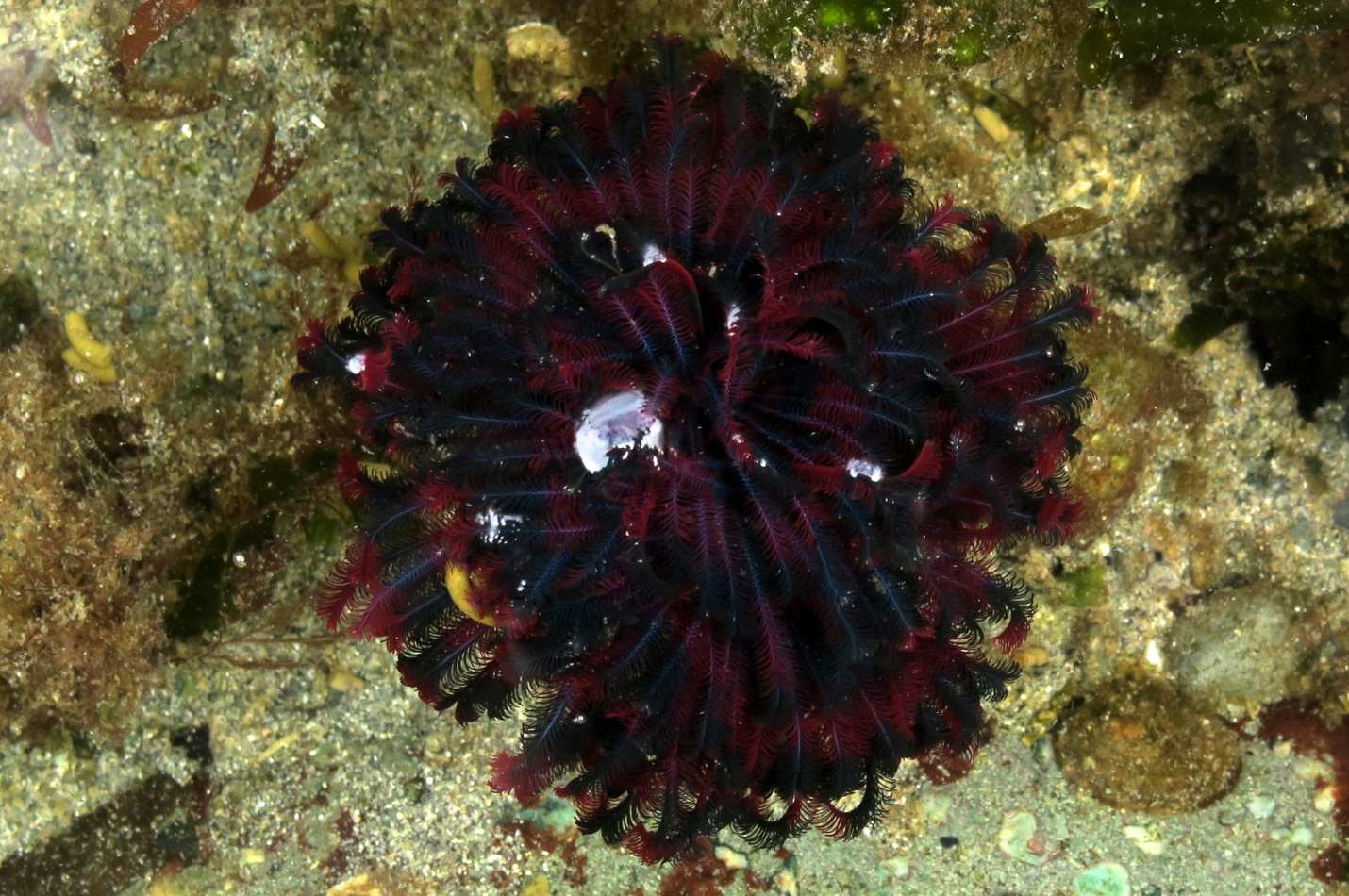
Figure 6: Animal – algae “look-alike” species (viewed here from directly above) – this feather-duster tubeworm has a similarity with Pleonosporium vancouverianum, a life form from a different kingdom. Willow Point, Strait of Georgia, B.C., Canada. April 30, 2021. Photo ID 27550 ©Seaweedwhisperings.com
Biology & Natural History Information:
Description:
This diminutive red seaweed grows to less than 2.5 cm tall. The thallus is a very small, uniseriate filament. Its distinctive feature is that it is alternately branched throughout its two or three orders of branching. All branches are uncorticated (lack a “bark”).
Habitat:
Pleonosporium vancouverianum, Alternate Skein, is an annual that grows on rocks, other animals, and epiphytically on other algae. It is found in the low intertidal to subtidal (to 20 meters) of semi-protected to semi-exposed habitats.
North Pacific Distribution:
Prince William Sound, Alaska, to Baja California, Mexico.
Remarks:
The sex organs occur along both sides of the branchlets. The spermatangia are somewhat more elongated than in other closely related species, while the sporangia contain many spores, that is to say that they are polysporangia rather than tetraspornagia.
Classification:
Phylum: Rhodophyta
Class: Florideophyceae
Order: Ceramiales
Family: Wrangeliacea
Genus: Pleonosporium
Species: Pleonosporium vancouverianum (J.Agardh) Setchell & N.L.Gardner 1903
Previous name(s): Callithamnion vancovuerianum J.Agardh 1876; Pleonosporium abysicla N.L.Gardner 1927 is currently considered to be a synonym of Pleonosporium vancouverianum.
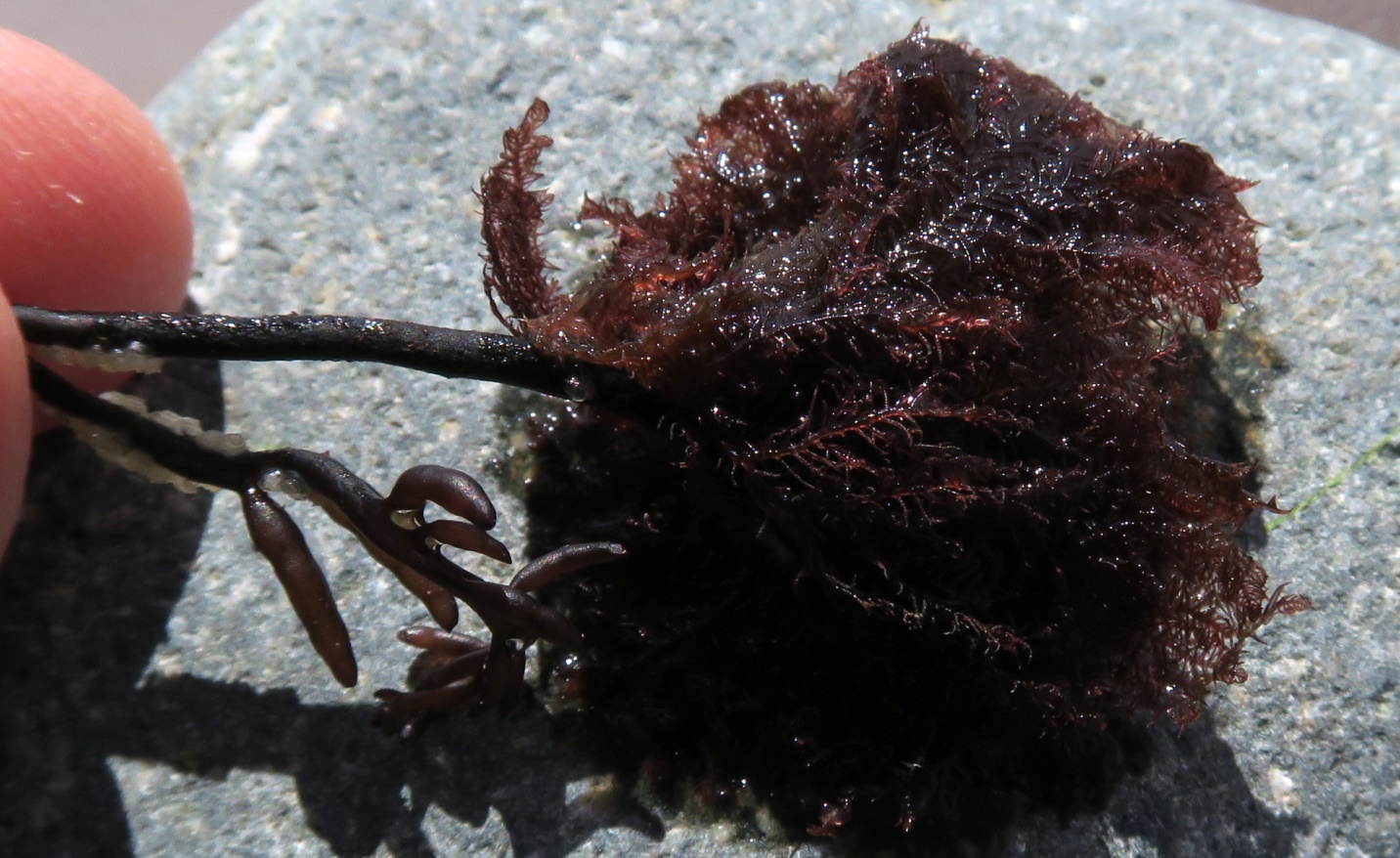
Figure 7: Pleonosporium vancouverianum, freshly out of water; this alga is growing epiphytically from the much thicker Sea Belly thallus. Goose Spit, Strait of Georgia, B.C., Canada. May 1, 2021. Photo ID 27551 ©Seaweedwhisperings.com
![]()